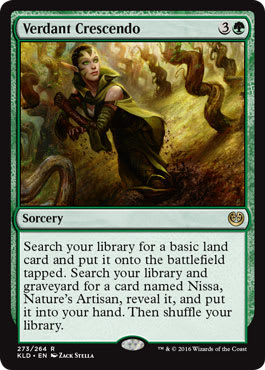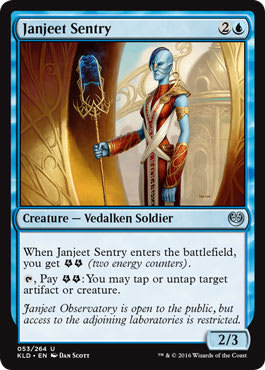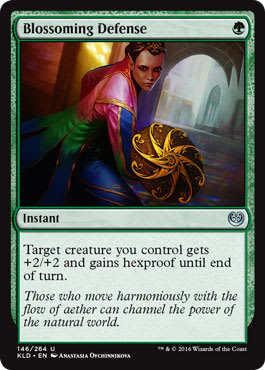Last week we put Chandra’s Planeswalker Deck under the knife, and we’re back this week to do the same with Nissa’s.
There are two Golden Rules we follow here with our Meddlings, designed to keep our deck-building inexpensive and readily attainable.
First, we can’t add mythics or rares. By limiting ourselves to commons and uncommons, it forces us to look critically at the tools we have available to us there, and really helps bring the theme of the deck to the front. Once we start with “4x Smuggler's Copter,” we start going down a different path (unless you’re Chandra, whose deck would have loved those).
Second, we’re only going to be using cards from sets present in the deck already, which here means Kaladesh only.
Here’s a look at the stock decklist, which is what you’d get just by picking one of these up at your FLGS or at CoostuffInc.
Nissa, Nature?s Artisan ? Kaladesh Planeswalker Deck| Wizards of the Coast
- Creatures (27)
- 1 Aethersquall Ancient
- 1 Bristling Hydra
- 1 Riparian Tiger
- 1 Sage of Shaila's Claim
- 2 Arborback Stomper
- 2 Empyreal Voyager
- 2 Janjeet Sentry
- 2 Long-Finned Skywhale
- 2 Longtusk Cub
- 2 Servant of the Conduit
- 2 Thriving Rhino
- 2 Thriving Turtle
- 3 Guardian of the Great Conduit
- 4 Terrain Elemental
- Planeswalkers (1)
- 1 Nissa, Nature's Artisan
- Spells (9)
- 2 Appetite for the Unnatural
- 2 Verdant Crescendo
- 3 Attune with Aether
- 2 Malfunction
- Lands (23)
- 11 Forest
- 8 Island
- 4 Woodland Stream
To begin with, let’s take a look at the themes of the deck. Like Chandra’s deck, Nissa’s offering overlays two different approaches.
First, you have the Planeswalker-centered theme that anchors the deck around a specific character, giving it its characteristic flavor. This consists of a single Planeswalker card, Nissa, Nature's Artisan, plus a small number of supporting cards like Verdant Crescendo and Guardian of the Great Conduit.
Then, it showcases one of Kaladesh’s premier mechanics, energy, and this makes up the bulk of the deck’s strategy. Though the degree to which energy is a parasitic mechanic has been the subject of much online discussion, as a self-contained deck mechanic is naturally does just fine. As we go about rebuilding the deck, this is what we’re going to want to pay closest attention to. There really isn’t much room to build on the Nissa element, since the Planeswalker and her special, supporting cards were all created for this product rather than being a subset of the greater Kaladesh environment.
Let’s pause for a moment to discuss the energy mechanic, since it will be the key to making this deck function. To do well with energy, two obvious things are needed. First, we need a way to generate energy, and then we need a way to spend it. In doing so, we want to achieve what all synergy-based decks aspire to, which is making the individual elements collectively punch above their weight.
It might be useful to imagine these on opposite ends of a spectrum. On one side, we have cards that produce energy but do nothing with it themselves, such as Sage of Shaila's Claim. On the other end would be cards that consume energy, but don’t generate any themselves (a hypothetical pole, since cards that use energy tend to bring at least a little with them up front).
Naturally, you would never want all of one or the other. Not only would you have a deck with an entirely useless mechanic, but you would also have an inefficient deck because the cards are assigned mana costs under the assumption that you’ll be using energy as it’s intended.
So for this deck to do well, we need to strike the right balance between energy generation and consumption. Ideally, we’ll want to focus on those cards which are themselves very good, without being overly reliant upon energy to contribute to the deck. A 2/2 creature which gets +18/+18 when you spend ten energy on it is only very rarely going to be anything other than a Grizzly Bear, and we wouldn’t want to play it regardless of the “potential upside.”
In short, we want cards that are consistently solid, and just get that much better when they interact with energy. With that in mind, let’s start making some cuts to clear out the deck’s chaff, and give us room to rebuild it as we’d like.
Our first cut is, in fact, Sage of Shaila's Claim. Though dropping three energy is helpful, the Sage doesn’t do much for us beyond that. Indeed, all we’ve gotten is a vanilla 2/1 for 2 mana, which doesn’t pass the ol’ “Vanilla Test” popularized on the Limited Resources podcast. We’ll have a number of ways to provide the deck some energy without having to resort to inferior options like the Sage, so it’s pink slips galore!
Somewhat ironically, the next to get the axe is the Terrain Elemental. Ironic, because here’s a card that absolutely aces the Vanilla Test — a two-mana 3/2 — but much like the Sage, it still doesn’t manage to bring enough to the deck. Our card slots for the finished product are very selective, and the Elemental only offers us efficiency — but little else.
Next up is the Thriving Rhino. The ‘Thriving’ creatures are a cycle, one for each color, with the others being the Thriving Grubs, Thriving Ibex, Thriving Rats, and Thriving Turtle. Each of these gives you the opportunity to slowly grow them into larger creatures each time they attack, by trading in two energy for a +1/+1 counter. The Rhino, a three-mana 2/3, gets the axe, but we passed right over the 0/3 Turtle. Why?
For one thing, the Turtle is a 1-drop, and gives us something relevant to do in the opening of the game. A 0/3 can blunt a lot of incoming damage if played early enough, and since our deck wants to have cards that synergize around energy, it stands to reason that time will often be on our side. When one of your closers is the Aethersquall Ancient, which needs eight energy to bounce the board, we’re happy to play cards that help slow things down a little in the red zone. The Turtle does that, but the Rhino does not.
Furthermore, the Rhino is inefficient. Sure, it can turn sideways on turn four for three points of damage, but only after we’ve spent 3 mana on it and two energy. We don’t have loads of creatures we can cast as a 1-drop that will do what the Turtle does here, but the Rhino has a lot more competition. Thus, the Rhino goes — and the Turtle remains.
Next out is the Janjeet Sentry. A 3-mana 2/3 is no more enjoyable in Blue than it is in Green, and while the ability to Twiddle artifacts or creatures is useful, that’s a very transient effect for our two energy. Again, it’s yet another creature that just doesn’t justify either its mana cost or its energy expenditure. Moving on, we then come to the Empyreal Voyager. The Voyager is a very solid card, with decent stats and abilities for 3 mana. In addition, it seems a decent enough energy producer, something that’s reminiscent of Rise of the Eldrazi’s Rapacious One — a creature that gives you an alternate resource equal to the amount of combat damage it’s able to inflict upon your opponent. And if Magic decks were 65 cards instead of 60, the Voyager might very well make the cut. This is one of those on-the-fence cards that’s difficult to cut, but you do so not because it’s bad but that other cards are simply better. Sorry, Voyager, keep on voyagin’.
The next card to be shown the door is perhaps a bit of a surprising choice — the Guardian of the Great Conduit. We were quite happy to keep the Renegade Firebrands last week in the Chandra deck, but unfortunately this Nissa exclusive doesn’t quite fit here. There are a couple of reasons why.
First, like the Firebrands, the Guardians are not all that great unless you have the requisite Planeswalker in play. I call these “feast or famine” cards, ones which are generally mediocre until you meet a certain requirement, and then they’re quite good. For Chandra, “mediocre” was a 3/2 that could become a 4/2 with first strike. Here, we have a potential 4/4 with reach and vigilance, which spends its idle time waiting for Nissa to appear as a 2/4 with reach. And there it is — while both aren’t that great, there’s more upside for Chandra with a 4-power first striker in an already aggressive deck, than there is for us here with a more defensive-minded 4/4. Sure, vigilance lets it contribute in both directions, but reach is purely defense. We already have the Turtles to keep a lid on the action in the red zone, we simply don’t have the need for any more speed bumps.
Additionally, the “mediocre” Firebrand still had a vital role to play in Chandra’s deck. That 3 power is just the ticket for crewing the deck’s vehicles, so even without a Planeswalker in place the Firebrand could still be a fully contributing member. The Guardians, much less so. As much as I hate to peel away some of the deck’s exclusive cards, it has to be done for the greater good. Sorry, Nissa.
The cuts continue with the Riparian Tiger. The Tiger offers a number of things in a single card, but none of them are really all that great. For 5 mana, we get a 4/4 trampler that can swing as a 6/6 if we throw some energy at it. That’s not terrible, but it’s also not good enough in a world where we want to be throwing Skywhales at people as early as turn four.
When Skywhales Attack
Nissa’s stock deck goes deep into creatures, but for our rebuild we’re going to want to scale that back a bit and let energy have some room to breathe in a non-creature way as well. Still, we’ll want to have a consistent suite of beaters, since that’s how the deck is going to get the job done.
Having gutted the stables, what’s left to build on? Well, we’ve already discussed the Thriving Turtles, which are an easy playset to run with. We’ll also round out a set of Longtusk Cubs. The Cubs are a very strong card, and contrast well against the Thriving Rhinos. For one thing, they’re on-curve as a two-mana 2/2 rather than a three-mana 2/3. Next, while they don’t enter play with energy, they have a repeatable way to generate more — by doing exactly what you want it to be doing. You don’t have to tap it, exile it, or put it in the corner. The Cub gets more energy by attacking your opponent, so there’s no ‘opportunity cost’ to pay. Finally, rather than a one-time conditional trigger, you can dump energy into the Cub to make it permanently bigger anytime you want to. This lends the creature greater survivability, since you can respond to burn or combat tricks by growing the Cub out of danger, rather than only getting to do it once per turn on the attack.
Next up is one of the deck’s key players, the Servant of the Conduit. Although the veterans amongst us might pine for the days of the Llanowar Elves, the Servant is as good as it gets in Kaladesh. Sure, you’ll have to pay energy if you want to ramp, but then it’s not as if you’re ramping every single turn with any mana dork. Indeed, the Servant is here largely to help ramp you into one of two cards: the Bristling Hydra, and the Long-Finned Skywhale. With a Servant in play, you’ll have the opportunity to start some heavy beating early by dropping one of these the following turn (just don’t miss your land drop!). The Hydra is bad news, and the Skywhale — thanks to evasion — will often be worse. Who cares that the Skywhale won’t be much help blocking for you — that’s what the Turtles are for.
We’re also going to drop in a couple of Arborback Stompers, which are drawing somewhat fanciful comparisons to Thragtusk but nevertheless offer a solid package. A 5/4 with trample is a card your opponent will have to answer, and if you’ve fallen behind on life, clawing five of it back is certainly respectable. We’ll also be keeping the Aethersquall Ancient, both for mana generation as well as board-clearin’ fun!
Best Supporting Cast
To back up the creatures, we’ve got a few tricks up our sleeve. Blossoming Defense is a fantastic two-way card that offers all sorts of hedges. It’s a great combat trick on either side of the red zone, giving a stats boost to the target. What’s more, it also offers hexproof, so it’s a good response to instant-speed removal when it comes time for that Skywhale to attack. We’ll take four of these. We’ll also throw in a pair of Aether Meltdowns, which shrink an opposing creature while adding some energy to our pool. Neither of our colors are all that great at removal, so we’re going to want to force our opponent on the back-foot through bigger and better beaters rather than worrying about tending their garden.
A trio of Glassblower's Puzzleknots helps improve our draw quality, as well as keep the energy following into the tank. Attune with Aether does much the same, while making sure we hit those all-important land drops so we can bring our biggest guns to bear.
Finally, we’ll naturally be keeping Nissa, Nature's Artisan and her pair of supporting spells, Verdant Crescendo. Between these, the scrying, and the Attunes, we’ll have plenty of ways to make sure we curve out well, and with a Servant of the Conduit in play well even be able to get ahead of the curve.
Here’s the final decklist.
Meddled Nissa ? Kaladesh Standard| Jay Kirkman
- Creatures (20)
- 1 Aethersquall Ancient
- 1 Bristling Hydra
- 2 Arborback Stomper
- 4 Long-Finned Skywhale
- 4 Longtusk Cub
- 4 Servant of the Conduit
- 4 Thriving Turtle
- Planeswalkers (1)
- 1 Nissa, Nature's Artisan
- Spells (15)
- 4 Blossoming Defense
- 2 Verdant Crescendo
- 4 Attune with Aether
- 2 Aether Meltdown
- 3 Glassblower's Puzzleknot
- Lands (24)
- 11 Forest
- 9 Island
- 4 Woodland Stream
Would you have gone a different way? Let us know in the comments below!
































